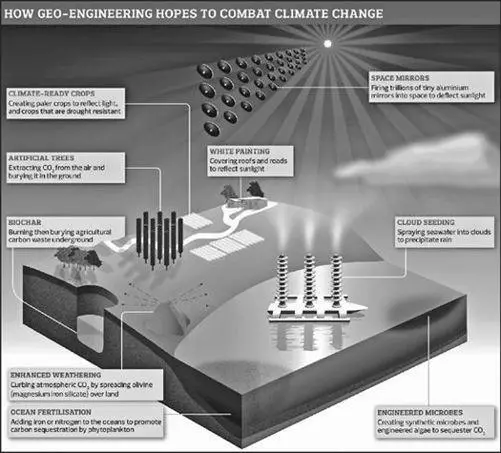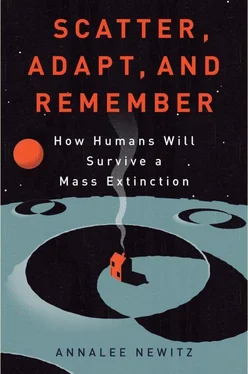So it’s possible that algae will be helping us in our geoengineering projects. Another possibility is that we’ll be enlisting the aid of rocks. One of the most intriguing theories about how we’d manipulate the Earth into pulling down carbon was dreamed up by Tim Kruger, who heads the Oxford Martin School’s geoengineering efforts. I met with him across campus from Driscoll’s office, in an enormous stone building once called the Indian Institute and devoted to training British civil servants for jobs in India. It was erected at the height of British imperialism, long before anyone imagined that burning coal might change the planet as profoundly as colonialism did.
Kruger is a slight, blond man who leans forward earnestly when he talks. “I’ve looked at heating limestone to generate lime that you could add to seawater,” he explained in the same tone another person might use to describe a new recipe for cake. Of course, Kruger’s cake is very dangerous—though it might just save the world. “When you add lime to seawater, it absorbs almost twice as much carbon dioxide as before,” he continued. Once all that extra carbon was locked into the ocean, it would slowly cycle into the deep ocean, where it would remain safely sequestered. An additional benefit of Kruger’s plan is that adding lime to the ocean could also counteract the ocean acidification we’re seeing today. Given that geologists have ample evidence that previous mass extinctions were associated with ocean acidification, geoengineering an ocean with lower acid levels is obviously beneficial. “A caveat is that we don’t know what the environmental side effects of this would be,” Kruger said, echoing the refrain I’d already heard from Driscoll and others.
Kruger’s idea depends on something that the algae plan does as well. It’s called ocean subduction, and it refers to the slow movement of chemicals between the upper and lower layers of the ocean. Near the ocean surface, oxygen and atmospheric particles are constantly mixing with the water. When this layer becomes saturated with carbon, we see carbon levels rise in the atmosphere because the ocean can no longer act as a carbon sink. But the lower reaches of the ocean can sequester massive amounts of carbon beyond the reach of our atmosphere. “If the ocean were well mixed overall we wouldn’t have the problem with climate change,” he said. “But the interaction between the deep ocean and the surface is on a very slow cycle.” The goal for a lot of geoengineers is to figure out how to sink atmospheric carbon deep down into the water, where a lot of it will eventually become sediment. Kruger’s limestone plan wouldn’t deliver the carbon directly to the depths, the way the algae plan might have. Instead, the lime would keep more carbon locked into the upper layers of the ocean, allowing time for the ocean’s subduction cycle to carry more of it down into the deep.
Another possible method of pulling carbon down with rocks is called “enhanced weathering.” In chapter two, we saw how intense weathering from wind and rain on the planet during the Ordovician period actually wore the Appalachian Mountains down to a flat plain. Runoff from the shrinking mountains took tons of carbon out of the air, raising oxygen levels and sending the planet from greenhouse to deadly icehouse. The Cambridge physicist David MacKay recommends this form of geoengineering in his book Sustainable Energy—Without the Hot Air . “Here is an interesting idea: pulverize rocks that are capable of absorbing CO 2, and leave them in the open air,” he writes. “This idea can be pitched as the acceleration of a natural geological process.” Essentially, we’d be reenacting the erosion of the Ordovician Appalachians. MacKay imagines finding a mine full of magnesium silicate, a white, frangible mineral often used in talcum powder. We’d spread magnesium silicate dust across a large area of landscape or perhaps over the ocean. Then the magnesium silicate would quickly absorb carbon dioxide, converting it to carbonates that would sink deep into the ocean as sediment.
However we do it, enhanced weathering relies on the idea that we could take advantage of the planet’s natural geological processes to maintain the climate at a temperature that’s ideal for human survival. Instead of allowing the planet’s carbon cycle to control us, we would control it. We would adapt the planet to our needs by using methods learned from the Earth’s history of extraordinary climate changes and geological transformations. Of course, this all depends on whether we can actually make geoengineering work.

This diagram illustrates how a number of geoengineering projects could be used to transform the Earth’s climate by drawing carbon out of the atmosphere and reflecting sunlight back into space. (illustration credit ill.17)
There is what Kruger and his colleagues call a “moral hazard” in doing geoengineering research, because it could popularize the idea that geoengineering solutions are a magical fix for our climate troubles. If policy-makers believe that there’s a “cure” for climate change just around the corner, they may not try to cut emissions and invest in sustainable energy. “It’s as if a scientist had some good results while testing a cancer cure in mice, and we started telling kids, ‘Hey, it’s OK to smoke, we’re about to cure cancer,’” Kruger said. The point is that we’re very far from being certain that geoengineering would work, and until we’ve got a lot more hard data, we have to assume that the best way to slow down climate change is to stop using fossil fuels.
There’s another worry, too. “There’s a potential for nation-states to see geoengineering activities as a threat,” Cascio cautioned. Harking back to what Driscoll said about how stratospheric reflective particles might cause cooling in some places, but warming in others, Cascio warned that solar management might cause famines in some regions of the world while others cool down into fruitful growing seasons. So one country’s climate solution might be another one’s downfall. A failed experiment in stratospheric particle injection might not just be horrible weather—it might be nuclear retaliation from countries who feel attacked.
To deal with these moral and political hazards, Kruger and several colleagues created the Oxford Principles, a set of simple guidelines for geoengineers to follow in the years ahead. Spurred by a call from the U.K. House of Commons Science and Technology Committee, Kruger met with a team of anthropologists, ethicists, legal experts, and scientists to draft what he called “general principles in the conduct of geoengineering research.” The Oxford Principles call for:
1. Geoengineering to be regulated as a public good.
2. Public participation in geoengineering decision-making.
3. Disclosure of geoengineering research and open publication of results.
4. Independent assessment of impacts.
5. Governance before deployment.
Kruger emphasized that the principles must be simple for now, because geoengineering is still developing. First and foremost, he and his colleagues want to prevent any one country or company from controlling geoengineering technologies that should be used for the global public good. Principles 2 and 3 touch on the importance of openness in any geoengineering project. (The rogue geoengineer in Canada notably violated principle 2, getting absolutely no input from the public before seeding the waters.) Kruger feels strongly that as long as the public is informed and able to participate, they won’t fear geoengineering in the way many people have come to fear other scientific projects, like GMO crops. Finally, the principles aim to prevent unchecked experimentation that could lead to environmental catastrophe, while also avoiding regulations so restrictive that they stifle innovation. Principle 5, “governance before deployment,” speaks in part to Cascio’s concern about countries interpreting geoengineering as an attack. Before we turn the skies white, or fill the oceans with lime, we must form a governing body that allows nations and their publics to consent to change the fundamental geological processes of the world. “There are huge risks associated with doing this, but doing nothing has huge risks as well,” Kruger concluded.
Читать дальше







![Аннали Ньюиц - Автономность [litres]](/books/424681/annali-nyuic-avtonomnost-litres-thumb.webp)





